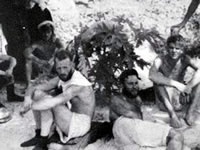 |
Found at www.colabee.blogspot.com
|
Although Egypt was supposedly independent, in practice the British Empire controlled the country. In 1940 the UK Ministry of War Transport requisitioned seven KML ships and placed five of them, including Abukir, under the management of the General Steam Navigation Company, a subsidiary of P&O.
On May 10, 1940 Germany invaded the Low Countries, overrunning Luxembourg within hours and the Netherlands within a week. The British Expeditionary Force (BEF) and French First Army advanced into Flanders to reinforce Belgian forces, and each sent a liaison mission to coordinate with the Belgian Grand Quartier ("High Command"). The British mission was named after its leader, the staff officer Major-General Henry Needham. Abukir was also sent to Belgium, where she arrived later in May at the Port of Ostend and unloaded a cargo of Army stores for the BEF.
German forces broke the French First Army, crossed the French frontier and on May 20 reached the Baie de Somme on the English Channel. This trapped the BEF and remaining French forces in northern Flanders, where they retreated toward Ostend, Nieuwpoort and Dunkirk. On May 27 Operation Dynamo began to evacuate the BEF by sea from Dunkirk. That afternoon at 1754 hrs the Needham Mission at the Belgian GQG reported that King Leopold III planned to negotiate a surrender to Germany. The Mission then retreated to the Port of Ostend, where Abukir was berthed. The Mission was among more than 200 BEF soldiers, RAF and Belgian Air Component personnel who crowded onto Abukir, along with 15 German prisoners of war, six priests, 40 to 50 women including a party of nuns from a convent in Bruges and a group of British schoolgirls. At 2220 hrs, under the cover of darkness, the little coaster sailed for England.
As Abukir slowly headed west for England, Luftwaffe aircraft bombed her for an hour and a half but failed to hit her. Then at 0115 hrs on May 28 a 44-knot Kriegsmarine E-boat, S-34 commanded by OLt.z.S Obermaier, attacked her off Nieuwpoort near the Westhinder or the Noordhinder lightvessel. Abukir Captain Rowland Morris-Woolfenden, took a zigzag course by which the coaster avoided two torpedoes from S-34. The coaster sighted S-34 off her port bow 20 minutes later. Morris-Woolfenden changed course to ram the torpedo boat, but with a top speed of only 8 knots Abukir was too slow. S-34 fired two more torpedoes. The first missed, but the second hit the coaster amidships, blowing her in two. Abukir burst into flames and sank within a minute. She was the first Allied ship to be sunk by an E-boat.
Many of those aboard were killed in the impact and sinking, but S-34 then trained a searchlight on survivors in the water and machine-gunned them. Abukir Second Officer, Temporary Sub-lieutenant Patrick Wills-Rust RNR, was on the bridge when Abukir was hit. Concrete slabs that had been installed to protect the bridge from machine-gun fire pinned him down and he went down with the ship. However, as the ship settled on the seabed the slabs were dislodged, freeing Wills-Rust and letting him return to the surface.
At first light five Royal Navy destroyers came to search for survivors: HMS Anthony Codrington, Grenade, Jaguar and Javelin. They spent several hours searching between the North Goodwin lightvessel and the Kwinte Bank lightbuoy but found only a small number of survivors (accounts vary between 26 and 33), including Captain Morris-Woolfenden, Sub-lieutenant Wills-Rust and two nuns. About 200 of the people aboard Abukir were killed. HMS Codrington rescued most of the survivors. They had been in the water for six hours.
In 1969 a commercial diver found Abukir wreck off the coast of Nord-Pas-de-Calais in northern France. Items found at the wreck site included plates, cups, teapots and cutlery initialled "KML" for the Khedivial Mail Line, Lee-Enfield .303 calibre rifle ammunition and rosary beads.
Recognizing many acts of wartime courage by seafarers, in December 1940 Lloyd's of London announced a new award, the Lloyd's War Medal for Bravery at Sea. The first such medal awarded was to Captain Morris-Woolfenden, and the second was to Sub-lieutenant Wills-Rust. Morris-Woolfenden was also awarded the MBE.












